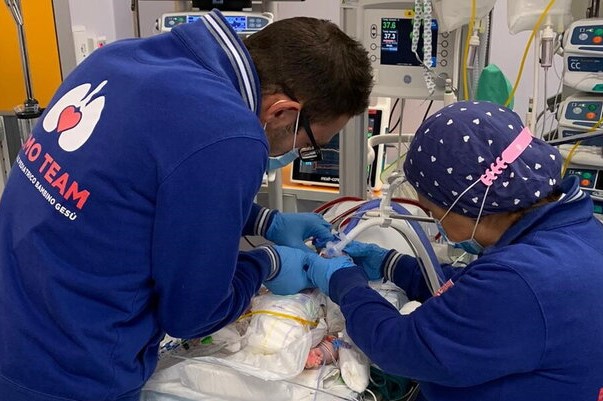
First guidelines for the use of ECMO in paediatric patients undergoing haematopoietic stem cell transplantation
First guidelines: recommendations on the management of the extracorporeal oxygenation technique ECMO in paediatric patients in an international document published in Lancet Child and Adolescent Health
The Bambino Gesù Children’s Hospital, in collaboration with 5 international scientific societies, has for the first time made available to resuscitators and oncohaematologists the Guidelines for the treatment with extracorporeal oxygenation (ECMO) of paediatric patients undergoing haematopoietic stem cell transplantation.
The document, consisting of 36 recommendations, also focuses on the ethical aspects of the use of ECMO for paediatric patients.
Published in the Lancet Child and Adolescent Health in recent days.
CHILD CARE PROFESSIONALS IN NETWOK: VISIT THE MEDICHILD BOOTH AT EMERGENCY EXPO
TRANSPLANTATION AND INFECTIOUS COMPLICATIONS
Haematopoietic stem cell transplantation (HSCT) is the only form of treatment for many paediatric haematological diseases, both neoplastic and non-malignant.
However, the treatment makes the immune system of these patients more fragile, making them vulnerable to infection.
Admission to intensive care for infectious complications refractory to medical treatment in the days following transplantation is therefore not uncommon.
In addition, transplanted patients may suffer damage, frequently involving an inflammatory response, to the lungs and heart.
In these cases, the use of Extracorporeal Membrane Oxygenation (ECMO) can be a very useful technique to enable the patient to overcome organ failure.
ECMO allows the heart and lungs to be put at rest by replacing their ventilatory and pumping functions.
Recently, advances in ECMO technology and more careful selection of patients undergoing haematopoietic stem cell transplantation have led to a significant improvement in patient survival.
For this reason, the Bambino Gesù Paediatric Hospital has managed to lead the preparation of the first multidisciplinary Guidelines for the use of ECMO in paediatric patients undergoing haematopoietic transplantation and cell therapy (CAR-T-cell therapy) with the collaboration of 5 international scientific societies (PALISI -Pediatric Acute Lung Injury & Sepsis Investigators, ESPNIC-European Society of Pediatric and Neonatal Intensive Care, EBMT-The European Society for Blood and Marrow Transplantation, ELSO-Extracorporeal Life Support Organization, PTCTC-Pediatric Transplantation and Cellular Therapy Consortium). The aim of the document is to clarify the indications, contraindications and critical points of ECMO management in this specific patient population to improve survival.
GUIDELINES ON ECMO IN PAEDIATRIC STEM CELL TRANSPLANT PATIENTS
The document is divided into 36 clinical recommendations.
Among the most important of these is the consensus of the scientific community on the use of ECMO for the management of acute cardio-respiratory failure in patients undergoing stem cell transplantation for a benign or malignant haematological disease with a low risk of recurrence.
In particular, the Guidelines emphasise that the use of ECMO has a greater chance of success if used some time after transplantation, i.e. as soon as the patient has achieved sufficient recovery of white blood cell and platelet counts, as well as of the immune system.
ECMO is contraindicated in patients where adequate engraftment has not yet been achieved.
The document clarifies the possible treatments to be undertaken during ECMO for refractory infectious cardio-respiratory diseases.
In these situations, the scientific community agrees to use cell therapies consisting of donor lymphocytes or those selected from a biobank to treat specific pathogens (such as viruses and fungi).
In addition, to ensure a higher level of safety and avoid the risk of adverse reactions (graft-versus-host disease), the Guidelines recommend the use of genetically modified lymphocytes so that they can be rapidly eliminated.
Dr. Matteo Di Nardo, Head of ECMO at Bambino Gesù and coordinator of the document points out that: “Particular attention is paid in the recommendations to involving the child’s family in the choice of treatment and to discussing the potential benefits and risks associated with the treatment.
A multidisciplinary consensus of intensivists, haematologists, surgeons and nursing staff on the use of ECMO and a strong therapeutic alliance with the family are essential prerequisites to guarantee the best clinical results for young patients”.
The guidelines, concludes Di Nardo, “will provide an international point of reference for all resuscitators and oncohaematologists faced with these issues”.
Read Also:
COVID-19 And Pregnancy, A New Study On 1,471 Women And Newborns From The University Of Pennsylvania
Pregnancy: What Happens To Your Hair During And After Giving Birth? Expert Answers
Policlinico Umberto I: Covid-19 Survivor Gives Birth In Extracorporeal Circulation (ECMO)


